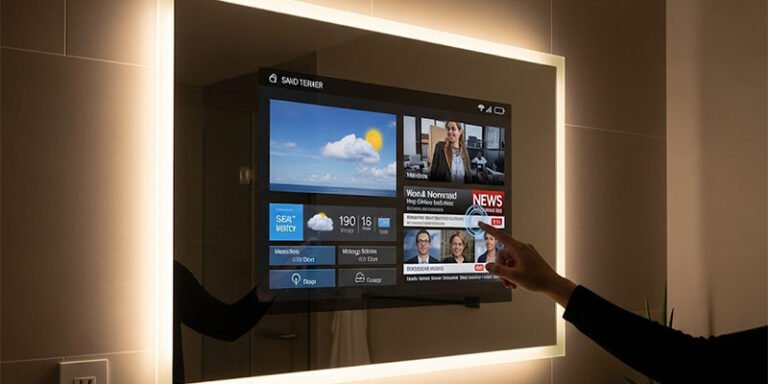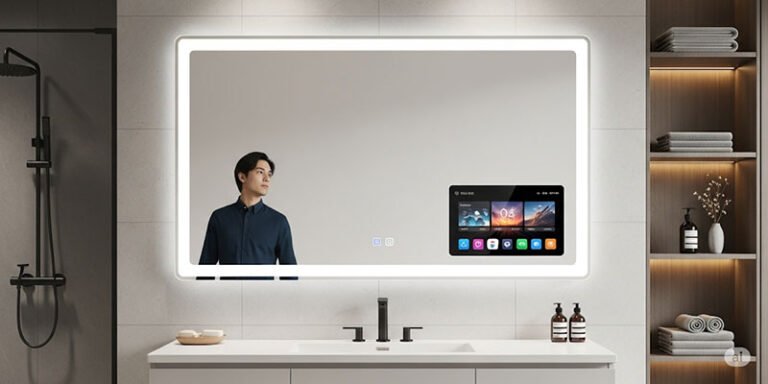Advertising mirrors are unique pieces that combine practical use with eye-catching design to promote businesses and products. These mirrors often feature logos, slogans, and artwork, making them stand out as both decorative and functional items. Over the years, they have gained interest from collectors and companies looking to create a memorable impact in their marketing efforts.
Vintage advertising mirrors can be found in bars, shops, and restaurants, as well as in private home décor. Today, custom advertising mirrors are still used by businesses to add character and a sense of history to a space. Their blend of art, branding, and craftsmanship makes them interesting to collectors and marketers alike.
Key Takeaways
- Advertising mirrors feature business branding and art on functional mirrors.
- These pieces are popular in décor and collectible markets.
- They remain a creative option in both modern marketing and interior design.
What Are Advertising Mirrors?
Advertising mirrors are used as both functional mirrors and as tools for marketing. They bring together reflective surfaces and visual branding, providing a platform to show ads or messages while still acting as a regular mirror.
Definition and Core Concepts
An advertising mirror is a mirror designed to display advertising content along with its usual function as a reflective surface. These mirrors often combine traditional glass with printed or digital elements.
There are two main types:
- Static advertising mirrors: These have logos, business names, or artwork printed or etched directly onto the mirror. The branding is always visible.
- Digital advertising mirrors: These use built-in screens or projections to show changeable ads, videos, or images when people are nearby or during certain times.
In many settings—like restrooms, elevators, or retail stores—advertising mirrors catch attention because users naturally look at them. Ads can appear in corners or fade in and out, blending with the reflective background. This makes ads less invasive but highly visible, especially in places where people pause for a few moments.
Historical Development and Evolution
Advertising mirrors first became popular in the late 1800s and early 1900s. Businesses would print or etch their names, logos, or slogans onto mirrors found in bars, restaurants, and stores. These antique mirrors are now collectibles.
Over time, advertising mirrors moved from small keepsakes and bar mirrors to large, branded fixtures in public spaces. With new technology, digital advertising mirrors have become common in malls, airports, and hotels. These use sensors, screens, or projectors to show dynamic ads while people use the mirror as normal.
The mix of tradition and digital features allows advertising mirrors to fit both classic and modern marketing strategies. Today’s mirrors may include touch screens or interactive elements, making them useful for gathering feedback, sharing discounts, or even displaying news and weather along with ads. This has made advertising mirrors a versatile part of many business environments.
Types of Advertising Mirrors
Advertising mirrors come in several forms, each designed for different locations and uses. Differences in size, placement, and features give each type unique benefits for marketing and brand visibility.
Wall Mirrors for Advertising
Wall mirrors for advertising are commonly found in high-traffic places like shopping malls, gyms, and restrooms. These mirrors serve both as functional reflective surfaces and as platforms for promotion. Brands often use etched or printed logos on the glass, or digital overlays to display changing advertisements.
Many modern wall advertising mirrors now include digital screens, combining reflection with animated content or video. This attracts attention and lets businesses display timely messages or interactive elements. Some smart wall mirrors can detect when someone is nearby, triggering a specific ad or message based on time of day or event.
Wall mirrors are favored for their large size and visibility. They maximize impact in crowded settings without taking up floor space. Materials can range from glass framed in metal or wood to advanced touchscreens.
Key Uses:
- Retail and public restrooms
- Shopping centers
- Gyms and hotels
Important Features: Reflective clarity, durability, ability to integrate digital displays.
Table and Compact Advertising Mirrors
Table mirrors and compact advertising mirrors are smaller and designed for desks, counters, or individual use. These mirrors often function as branded gifts or customer incentives, making them common in beauty and hospitality industries.
Compact advertising mirrors are shaped like ovals or circles and can range from button-sized to the size of a small paperweight. Businesses often imprint their name or logo directly on the mirror’s back or frame. These mirrors work well as souvenirs or giveaways, offering everyday value while keeping the brand visible.
Table mirrors may also appear in cafes, salons, or hotel lobbies, offering subtle reminders of a product or service. Portable options allow users to take these branded items home, extending the reach of the advertisement.
Key Uses:
- Customer gifts
- Beauty and skincare counters
- Restaurant or hotel tabletops
Important Features: Portability, practicality, customizable design.
Floor Mirrors in Marketing
Floor mirrors used for advertising are large, freestanding pieces commonly placed in showrooms, clothing stores, or event venues. Their size makes them highly noticeable and effective for making a brand impression.
Some floor advertising mirrors include digital displays that can show rotating messages or even support augmented reality experiences, like virtual try-ons in clothing stores. The combination of life-sized reflection with promotional content creates a memorable and engaging interaction for customers.
These mirrors often feature durable frames and bases to keep them stable in busy areas. Advertising can be integrated by etching or printing on the glass, or by applying branded decals around the frame.
Key Uses:
- Fashion retail stores
- Trade shows and exhibitions
- Events and pop-up shops
Important Features: Large viewing area, sturdy construction, potential for digital enhancement.
Mirror Advertising in Modern Marketing
Mirror advertising uses advanced technology to blend reflective surfaces with digital displays. Businesses use this unique mix to grab customer attention, promote products, and create memorable brand experiences.
Digital Mirror Advertising Technology
Advertising mirrors use special screens that sit behind or inside traditional mirrors. These displays can show images, videos, or informative content while still working as regular mirrors.
Smart mirrors add sensors and network connectivity. This lets them deliver targeted ads based on time of day, location, or even customer gender.
Key features include:
- High-definition screens
- Motion or facial recognition sensors
- Remote content management
- Integration with mobile devices
This technology helps brands target their message more effectively, while the mirror remains functional for users. As a result, digital mirror advertising combines everyday practicality with interactive displays for marketing.
Interactive and Experiential Campaigns
Mirror advertising is often used to create interactive campaigns that engage customers in real time. For example, smart mirrors in clothing stores let customers see themselves wearing different outfits through augmented reality.
In beauty salons or gyms, mirrors may show product suggestions, tutorials, or health tips based on customer preferences. This personalized content makes the experience more relevant and memorable.
Interactive advertising mirrors use touch, voice commands, or sensors to gather feedback or display customized offers. This level of engagement can increase dwell time, boost product sales, and encourage repeat visits.
Deployment in Commercial Spaces
Advertising mirrors are now found in many public and private spaces. Common locations:
- Retail stores (fitting rooms, beauty sections)
- Hotels (bathrooms, lobbies)
- Gyms and fitness centers
- Airports and public restrooms
- Restaurants and bars
Businesses install these mirrors to reach a broad range of customers where they naturally pause and look at their reflection. In high-traffic areas, digital mirror ads can cycle through multiple messages to suit different audiences.
The placement and size of advertising mirrors vary to fit each location’s needs. For example, large wall-mounted mirrors in store entrances can greet customers with promotions, while smaller versions in restrooms may show short, targeted messages.
Design and Artistic Elements
Advertising mirrors are more than just reflective surfaces. They often feature creative designs, unique artwork, and carefully selected accessories to draw attention and enhance their visual appeal.
Integration of Art and Paintings
Many advertising mirrors include artistic elements like hand-painted borders, illustrations, or prints based on famous paintings. Businesses sometimes commission artists to create custom imagery that matches their brand or message.
These artistic touches make a mirror both a promotional tool and a decorative centerpiece. For example, vintage advertising mirrors might use Art Nouveau artwork or detailed etchings as part of their frame. Some mirrors even feature reproductions of classic paintings, combining functionality with fine art.
The integration of original or themed artwork can help the mirror become a conversation piece. This creates a connection between the brand and the viewer, encouraging longer engagement.
Customization and Branding
Customization is key in advertising mirrors. Companies use logo etching, color matching, or branded motifs to make their mirrors unique. The placement of branding elements on the mirror is important for visibility without overwhelming the design.
They may add company slogans or images tied to a product launch. Popular customization techniques include:
| Technique | Description |
|---|---|
| Etching | Uses acids or lasers to create permanent marks |
| Printing | Places vibrant images or logos on the mirror |
| Painting | Allows for more detailed, freehand designs |
This level of personalization turns a simple mirror into a branded advertisement. Careful design ensures the branding feels balanced with the rest of the mirror’s artistic features.
Decorative Accessories and Vases
Advertising mirrors are often displayed with decorative accessories to enhance their effect. Common additions include vases, flowers, or small sculptures placed nearby.
A beautiful vase filled with seasonal flowers can help reflect vibrant colors and draw extra attention to the mirror’s design. The combination of mirror and physical accessories makes the advertisement feel more inviting and layered.
Accessories can reinforce a theme, such as using vintage vases for a classic product line or modern items for a contemporary ad. These elements help the entire display stand out and support the brand’s message.
Advertising Mirrors in Interior Décor
Advertising mirrors can blend style and history into everyday spaces. They work well with both traditional and modern room styles and can highlight furniture, cabinets, and décor accents like books and collectibles.
Furniture and Cabinets Incorporating Advertising Mirrors
Some furniture and cabinets are designed specifically to display advertising mirrors. Bars and restaurants often use mirrored panels featuring old brand logos or vintage ads on their cabinet doors or backsplashes. This creates a unique focal point and reflects light across the room.
A display cabinet with a mirrored back showing a historic beverage brand adds a nostalgic, conversational touch. Vanity tables, sideboards, and wall-mounted shelving sometimes feature these mirrors too. The reflective surfaces add to the feeling of space and brightness in a room, while the ad artwork can coordinate with the overall décor style, whether classic or retro.
Many people also repurpose vintage advertising mirrors by installing them in wardrobe doors or mounting them on entertainment centers. Below is a simple overview:
| Furniture Type | Use of Advertising Mirrors |
|---|---|
| Bar cabinets | Mirror doors, back panels, shelving |
| Vanity tables | Mirror inserts |
| Sideboards | Decorative fronts |
| Wardrobes/closets | Door accents |
Books and Collectibles as Décor Accents
Advertising mirrors pair well with books and collectibles for a layered decorative look. Collectors often place smaller advertising mirrors on bookshelves, mixing them with vintage books that share a similar time period or brand.
Placing a mirror with an antique soda or beer brand near a book about product design creates visual links between items. Collectibles like old tins, glass bottles, or branded coasters work well alongside advertising mirrors, reinforcing a theme.
Some people group advertising mirrors with stacks of books on coffee tables, blending literature and historic branding. Well-chosen décor accents, such as framed pamphlets or collectibles matching the mirror’s subject, help create a cohesive display that draws interest without making the space look cluttered.
Collecting and Preserving Advertising Mirrors
Vintage and antique advertising mirrors attract collectors with their detailed artwork, historic brand logos, and unique style. These collectible items require careful handling and understanding of both their market and proper care to keep their value and appearance.
Antique and Vintage Market
Advertising mirrors were popular from the late 1800s into the early 20th century. Pocket mirrors with promotional graphics, small framed mirrors, and bar or store advertising pieces can all be found. Common subjects include companies from beverages, tobacco, beauty products, and early automobiles.
Collectors look for good condition, clear graphics, and original backing. Rarer items may feature discontinued products or regional brands. Prices range widely, from under $50 for common examples to several thousand dollars for rare finds. Provenance and specific historic details can add value.
Collectors often shop at antique stores, online marketplaces like eBay, or specialized shows. Interest in advertising mirrors is steady, making it an attractive niche for those interested in advertising history or decorative art. Pieces from well-known beer, soda, or tobacco brands are especially sought after.
Care, Maintenance, and Display
Proper care starts with gentle cleaning. Only use a soft cloth and avoid any harsh chemicals or water, as old mirrors can have fragile silver backing and celluloid images. If a mirror is very dirty, a dampened microfiber cloth with a tiny amount of mild soap may help. Always test on a small area first.
Display advertising mirrors out of direct sunlight to prevent fading. Avoid humid places since moisture can damage the backing and the graphics. Using stands, shelves, or shadow boxes helps keep them secure and visible without risk of dropping.
If a mirror is loose or the frame is unstable, it’s best to consult a professional restorer. Trying to fix it at home can cause more harm. To protect value, avoid removing any labels or replacing parts unless absolutely necessary.
Here’s a simple table for care:
| Care Step | What to Do | What to Avoid |
|---|---|---|
| Cleaning | Soft, dry cloth | Harsh chemicals |
| Storing | Dry, stable environment | Humidity, sunlight |
| Handling Repairs | Consult professionals | DIY fixes |




